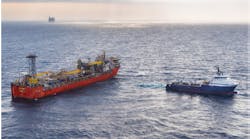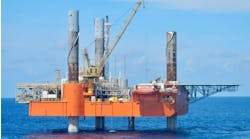Cor Verdult, Albert Wijninckx, Heerema Marine Contractors
In 2004, Hess awarded Heerema Marine Contractors (HMC) a transportation and installation contract for the Okume project offshore Equatorial Guinea. A number of logistical challenges were encountered leading up to the contract deadline in October 2006.
The Hess-operated Okume complex central processing facility’s jacket is on a barge being towed by theRetriever tug with HMC’s Thialf in the background.
The Okume Complex comprises the Okume, Oveng, Ebano, and Elon fields, which are being developed with two TLPs and four fixed platforms. Production from the fields is gathered at a central processing facility (CPF) in the Elon field. From there, a 15-mi (24-km) subsea pipeline connects to theSendje Ceiba FPSO.
HMC’s workscope included the transportation and installation of four fixed platforms, tendon foundation piles, tendon sections, and tendon buoyancy modules (TBM). Additional commitments included the dry tow of two TLPs from Korea to the offloading site in West Africa, wet tow of the TLPs from the offloading site to installation site, and installation of the TLPs.
The 5,900-metric ton (6,504-ton) integrated TLPs were installed on the Oveng and Okume fields in 899 ft (274 m) and 1,640 ft (500 m) water depth, respectively, the 6,400-metric ton (7,056-ton) CPF was installed in 205 ft (62 m) water depth, and the three satellite platforms were installed in water depths from 143 to 228 ft (44 to 69 m).
Schedule
Phase 1 (1Q 2006) called for HMC’s deepwater construction vesselThialf to spend eight to nine weeks in Equatorial Guinea to install tendon foundation piles, tendons, all four jackets, the three satellite platforms, CPF, topsides of satellite 1 and 2, and two TLPs. The TLP installation required a 24-hour weather window with wave heights of less than 2 ft (0.6 m). It was established during the tender stage that wave heights would not be favorable for the Thialf in mid-May through October.
Phase 2 (October 2006) scheduled theThialf to be in Equatorial Guinea for eight or nine days to install satellite 3 and the CPF’s topsides and bridge.
HMC usually schedules transportation and installation projects using a fixed sequence and the “just-in-time” principle. But it was determined that this method was not feasible for Phase 1. Any delay in fabrication and transportation could impactThialf’s schedule, with costly consequences. Sending the barges too early to Africa would result in expensive vessel, tug, and barge spreads waiting to be unloaded off the coast of West Africa.
Logistics
In Phase 1,Thialf (and most of the installation equipment) was scheduled to sail from Europe. The 4,600-mi (7,403-km) trip was estimated to take up to five weeks, depending on conditions in the North Sea and Atlantic Ocean. And five 400-ft (122-m) cargo barges were needed to move structures about 6,700 mi (10,783 km) from the Gulf of Mexico to Equatorial Guinea. Each trip was expected to take up to seven weeks, depending on the weather in the GoM and Atlantic. Limited availability of bunker facilities for the tugs moving between the US and Africa also could impact tow speed and duration.
HMC subcontracted the load out and transport of the two mini TLPs to Dockwise, which assigned theMighty Servant 1 for the job. The 10,500-mi (16,898-km) transit from South Korea to Equatorial Guinea was estimated to take up to six weeks.
Mobilization ofThialf, which was anticipated to start in Rotterdam, actually began in the GoM. Thialf and the tug Retriever left for Africa on Dec. 30, 2005, and were scheduled to arrive in Malabo for customs clearance on Feb. 22, 2006.
The tendon buoyancy modules and tendon piles were loaded onto HMC’s bargeH404 in Ingleside, Texas.
On Dec. 29, bargeH404 towed by HMC’s tug Husky left the Thialf for Corpus Christi, Texas, where the barge was to be loaded with the tendon foundation piles and the TBMs. On Jan. 16, H404, still towed by Husky, left Ingleside, Texas, and was scheduled to arrive “just-in-time” alongside Thialf in Equatorial Guinea to kick off the installation program with the tendon foundation piles for the Okume and Oveng TLPs.
The satellite jackets were used as gap fillers in the schedule. This created the flexibility needed to achieve a continuousThialf program. Together with the client, HMC negotiated shorter load-out periods with the fabrication yards to ensure both the tendon foundation pile barge H404 and the tendon barge C500 would leave on time.
Meanwhile, bargeC410 had a delayed sail-away because of bad weather, and the company had to charter a tug to tow the delayed-barge loaded with satellite 1 jacket, satellite 1 and 3 piles, and satellite 1 and 2 decks. But C410 arrived just in time alongside the Thialf to carry out the installation program.
The barge originally nominated to carry satellite 2 and 3 jackets was damaged, and the replacement barge arrived late at the fabrication yard, delaying sail-away from the GoM. HMC managed to complete Phase 1 on time only by changing the sequence of installations whileThialf worked continuously for two months.
The logistics for Phase 1 seemed straightforward. SinceThialf had another scheduled commitment in West Africa, the Okume lifts could have been done either before or after that project. HMC had to make sure that the vessel, mobilizing from Rotterdam, and the two 400-ft (122-m) cargo barges, sailing in convoy from Corpus Christi, would arrive in Equatorial Guinea at the same time, in late September 2006.
Unfortunately, HMC was informed in January 2006 that one of those barges was not available to transport the CPF deck, nor was a replacement available. Delay in first oil of six to 12 months seemed inevitable. For HMC, this meant a costly extra trip forThialf to Africa in 2007
Solution
The only feasible solution was to combine the schedules of the two projects for bargeH627. HMC needed approval from all parties to transport the Phase 2 structures on one barge. If this could be achieved, the second 400-ft (122m) barge would not be required.
HMC’s bargeH627 in transit from Ingleside, Texas, with the CPF and satellite 3 topsides onboard.
H627 was scheduled to be used for deck transportation at the end of 2006 for a project in Brazil. The plan was to prepare the vessel for Equatorial Guinea in Rotterdam, sail the barge to Corpus Christi, and load the CPF deck and all other structures before transit to Africa. There, Thialf would lift and install all the structures. After completing the Hess project, the barge would be cleaned and prepared for its trip to Brazil. This proposal was challenging and costly.
Kiewit dredged their harbor to accommodate the load-out of the CPF deck and other structures ontoH627. HMC prepared the barge in record time and contracted a large tug to shorten the tow periods to protect the schedules for Hess and the project in Brazil. Shortly thereafter, Thialf cleaned H627. A total of 600 metric tons (661 tons) of steel was removed from the barge before it departed for Brazil.
Thialf arrived at Malabo on Sept. 27 and completed the installation of Phase 2 on Oct. 5, 2006. The TLPs were installed without crane assistance, floated over pre-installed tendons, lowered by ballasting, and locked in place with hydraulic clamps.
BargeH627 left for Brazil on Oct. 4 and was on time for the second project.






